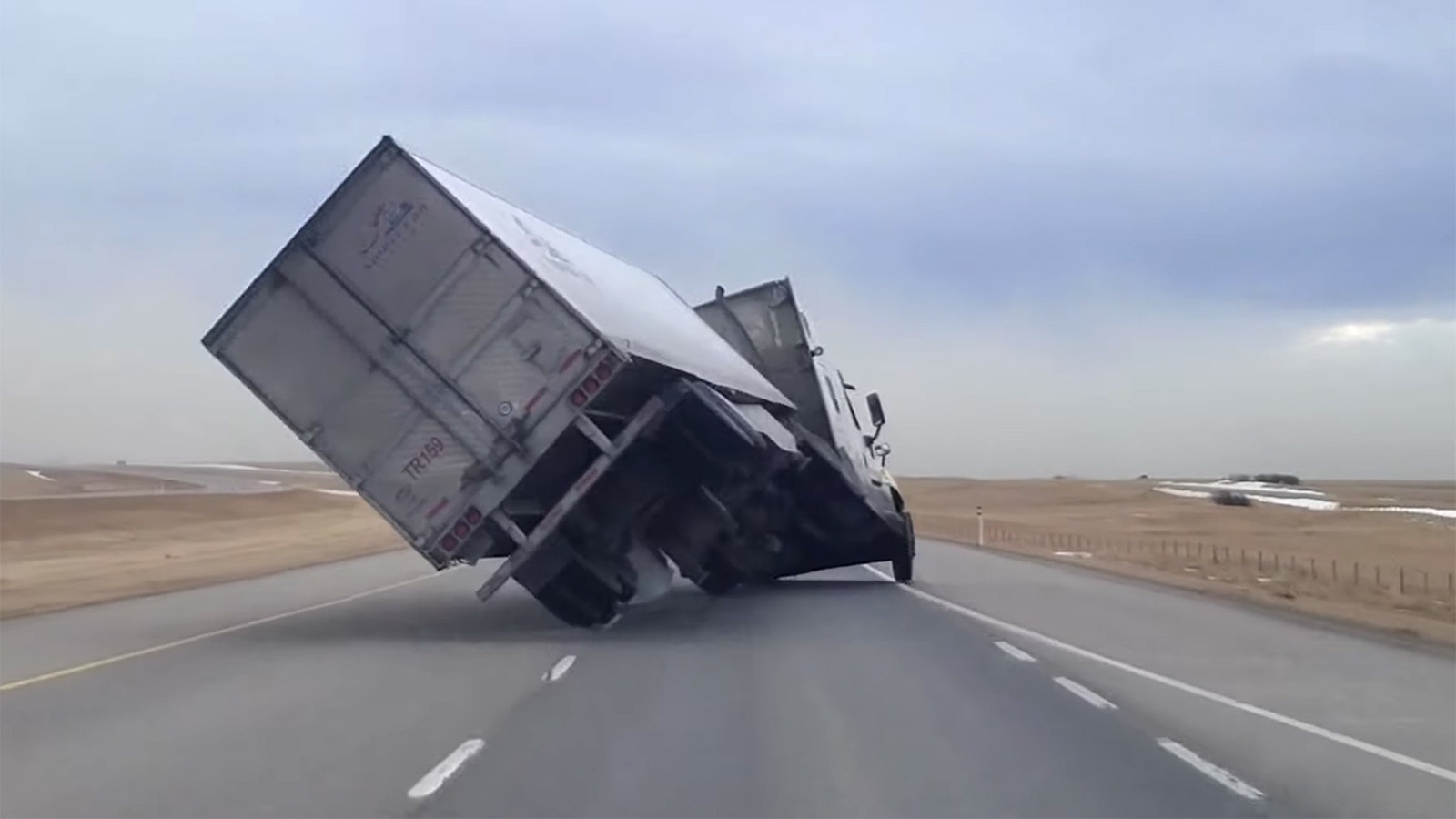The Wyoming Department of Transportation wants to reduce crashes caused by high-profile vehicles blowing over on the state’s windy highways with weight restrictions starting next year.
And anyone violating the regulations could be hit with a misdemeanor criminal charge and risk losing their operator’s license even on a first offense.
WYDOT will expand its policy for road closures on high-clearance vehicles ranging anywhere from 10,000 to 75,000 pounds.
The closures will be displayed on digital roadside signs with wind gust speeds also provided to drivers. During the Wyoming Legislature’s Joint Transportation, Highways and Military Affairs Committee last week, Vince Garcia, GIS/ITS program manager for WYDOT, said the signs will be updated every 60-90 minutes.
Through a new mobile app, WYDOT also will offer a specific vehicle review process for drivers through a fully automated process.
Flatbeds and tankers will be given automatic authorization, but vehicles with a box trailer will be evaluated based on their weight, route and current and forecasted wind speed conditions. Drivers approved for travel will be given a time-limited authorization to travel and will be warned they are traveling at their own risk.
Garcia told Cowboy State Daily the new restrictions could start as soon as January 2024.
“That’s the hope,” he said. “We have a lot of things to do.”
WYDOT considers the weight restrictions an in-house rule that does not need legislative approval.
Numbers Don’t Lie
A recent WYDOT study found that an average of 47.4 vehicles per year blew over on Interstate 80 over the last five years. The most common month for blow-overs on I-80 is November.
Of these crashes, 29.1% led to some form of injury or a fatality and only 63.2% happened with dry road conditions. The majority involved commercial trucks.
Last November, more than 100 mph winds caused dozens of semitrucks to topple over across Wyoming. During this weather event, WYDOT closed Interstate 25 for all light and high-profile vehicles and posted an “Extreme Blow-Over Risk” warning for Interstates 25 and 80.
One driver who had his 4,000-pound trailer tossed by a gust expressed frustration to Cowboy State Daily that a WYDOT sign alerted him the winds were only 60 mph winds when in reality, they were closer to 110 mph.
Enhancing The Stick
The committee also discussed and passed draft legislation adding a misdemeanor charge for anyone found guilty of violating a wind closure, carrying a mandatory $2,500 fine and up to 30 days in jail.
State Sen. Brian Boner, R-Douglas, co-chair of the Transportation Committee, also suggested an amendment adding the violation to a list of around nine other charges that require a commercial driver’s license be revoked for one year after a single infraction. The committee unanimously passed the amendment.
Sen. Stephan Pappas, R-Cheyenne, also suggested the idea of imposing other restrictions for drivers carrying hazardous materials.
Pappas suggested creating enhanced penalties for drivers found to be repeat offenders of the wind restrictions as a way to encourage companies to force their drivers to follow the law.
“I’m really curious about what we can do to enhance the stick,” he said.
Rep. Landon Brown, co-chair of the Transportation Committee, agreed and said he likes the idea of drivers who violate the restrictions twice of being disqualified from driving in Wyoming.
Garcia recommended implementing a model more similar to the fines issued for infractions committed in construction zones, which are typically double.
What’s Used Now?
It wasn’t until 2011 that WYDOT started implementing closures for light and high-profile vehicles.
The new weight restrictions will be announced on digital messaging and online information systems.
WYDOT now alerts drivers to road conditions on pre-trip information systems like their own website, the Commercial Vehicle Operator Portal (CVOP), the Wyoming 511 phone system, app, text and email reports, social media and YouTube. It also provides road information with third-party providers like Google and SiriusXM.
The new weight restrictions will be shared on these platforms and the specific vehicle review process will be directly accessible from CVOP.
But the primary mode of communication will be roadside information systems, which include 162 dynamic message signs and variable speed limit signs along problem areas.
Using University of Wyoming research, WYDOT plans to roll out a new notification system for the weight restrictions and other road updates. This will include:
- An updated pre-event system to provide expected wind closures with social media posts and video forecasts.
- Add information to CVOP to allow a driver to self-evaluate their blow-over risk and show windows of opportunity for them to drive.
- Create an operational system to improve enforcement.
Extreme blow-over risk signs will be continued in locations where there is not enough signage to close a road.
“It’s just a good indication for the driver that this (weather) is severe,” Garcia said.
Disconnect
Rep. Ryan Berger, R-Evanston, speculated whether there is a disconnect between what WYDOT and individual drivers consider to be high- and low-profile vehicles.
Garcia agreed and said to bridge the disconnect, his department will try to identify specific weights of vehicles moving forward. He wants the new weight restrictions to be more proactive and self-enforceable rather than relying on punishing factors.
Garcia said one of the challenges of implementing wind restrictions on different types of vehicles is that they can be rather difficult to define. He said how much weight a vehicle is carrying, the wind direction, roadway geometry, shape of vehicle and experience of a driver all play into whether a vehicle is considered low or high profile.
“It’s very complex,” he said.
Sheila Foertsch, president and CEO of the Wyoming Trucking Association, said her organization generally supports light- and high-profile penalties, but it’s ultimately the driver’s decision to proceed in inclement weather.
Another challenge for drivers, she said, is changing weather conditions as drivers move from state to state.
“The more tools we can give them, I’m very excited,” she said.
Roll Out
To start, the weight-based closures will only be implemented on the state’s interstate highways because they already have digital signs and environmental sensors. According to WYDOT data, the vast majority of blow-over crashes in Wyoming happen on I-80 and I-25 between Cheyenne and Casper. Often, these crashes lead to closures and traffic delays.
Closures will be based around communities where travelers can get refuge, access to food and fuel.
Garcia said WYDOT does not have the ability to present digital signs in languages other than English but have more flexibility to do so with their mobile application. He said a recent study found that about 20% of the people who use this app are Spanish speakers.
Foertsch said the signage limitations do create a language barrier but if their messages can be kept brief and to the point they will most likely be successful in communication.
Leo Wolfson can be reached at leo@cowboystatedaily.com.





